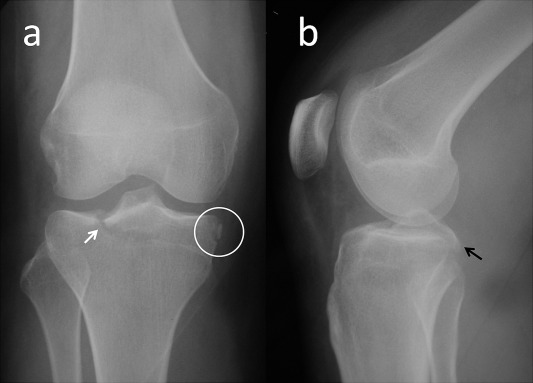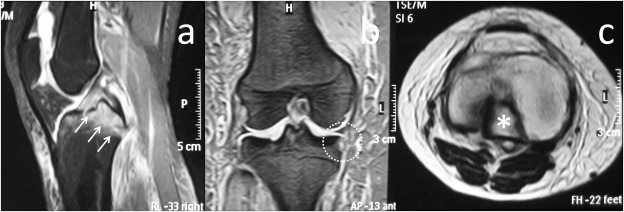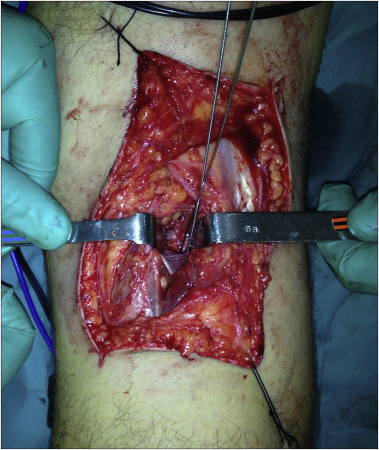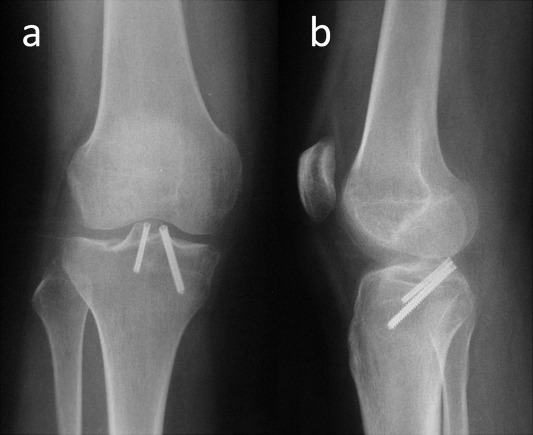Abstract
Reverse Segond fracture is originally described as an indirect radiographic clue for a specific injury complex of the knee joint that includes posterior cruciate ligament (PCL) rupture and medial meniscal tear. Herein, we describe a case with reverse Segond fracture associated with PCL avulsion fracture instead of PCL rupture. According to current literature review, reverse Segond fracture is not only associated with PCL and medial meniscal injuries, but also frequently associated with anterior cruciate ligament (ACL) and medial collateral ligament (MCL) injuries. Furthermore, medial meniscus and PCL may remain intact.
Keywords
Segond fracture ; Reverse Segond fracture ; Posterior cruciate ligament rupture ; Posterior cruciate ligament avulsion fracture
Introduction
Segond fracture is a small avulsion fracture from the lateral aspect of the proximal tibia just below the level of the tibial plateau, best demonstrated on anteroposterior (AP) view of the knee. The mechanism of injury is internal rotation of the tibia associated with varus stress on a flexed knee that creates tension on the lateral capsule and lateral capsular ligament, also called anterolateral ligament (ALL).1 ; 2 This, in turn, causes an avulsion fracture at the insertion of ALL on the lateral plateau. This innocent looking avulsion fracture is frequently associated with anterior cruciate ligament (ACL) rupture and lateral capsular or lateral meniscal tear, resulting in chronic anterolateral knee instability.3
In 1997, Hall and Hochman described a reverse Segond-type fracture, also called medial Segond fracture, affecting medial tibial plateau.4 The mechanism of this injury and the constellation of radiographic findings are the reverse of that seen in the classical Segond fracture. The avulsion fracture of the medial tibial plateau is caused by the valgus stress and external rotation of a flexed knee. Hall and Hochman proposed that this radiographic finding is another radiographic clue for a specific injury complex and associated with rupture of the posterior cruciate ligament (PCL) and medial meniscus tears.4
To the best of our knowledge, a total of 13 cases have been reported in current English literature after the description of reverse Segond fracture (Table 1 ). In contrast to original description, each individual case had variety of concomitant knee injuries that raises a question whether reverse Segond fracture represents a specific injury complex of the knee. Herein, we describe one further case with reverse Segond fracture associated with PCL avulsion fracture instead of PCL rupture which is only reported once previously in current English literature.5 We also reviewed all previously published cases of reverse Segond fracture and discussed its demographic and clinical characteristics, imaging findings, and treatment options.
| Author | Year | Age | Sex | Mechanism of injury | Bony injuries | Ligamentous injuries | Meniscus injuries | Outcome |
|---|---|---|---|---|---|---|---|---|
| Hall and Hochman | 1997 | 24 | F | Pedestrian traffic accident Valgus stress, external rotation of the flexed knee | Cortical avulsion fracture off the medial rim of the medial tibial plateau | PCL rupture MCL rupture ACL partial rupture | Medial meniscus tear | ? |
| Cohen et al | 2001 | 17 | M | Fall from height (60 cm) Hyperextension, varus rotation and posterior translation | Marginal fracture of the anteromedial tibial plateau | PCL rupture Popliteal tendon rupture Avulsion of the biceps tendon LCL rupture | None | ? |
| Escobedo et al | 2002 | 29 | M | Struck by a vehicle | Marginal fracture of the anteromedial tibial plateau Lateral tibial plateau fracture | PCL avulsion fracture MCL | Medial meniscus peripheral tear ? | ? |
| 36 | F | Struck by a vehicle | Marginal fracture of the anteromedial tibial plateau Lateral tibial plateau rim fracture | PCL avulsion fracture MCL rupture ACL avulsion fracture | Medial meniscus peripheral tear ? | ? | ||
| 52 | F | Motor vehicle accident | Marginal fracture of the anteromedial tibial plateau | Knee dislocation, patellar dislocation PCL rupture MCL rupture ACL rupture | Medial meniscus peripheral tear ? | ? | ||
| Archold et al | 2004 | 31 | M | Sport trauma | Marginal fracture of the anteromedial tibial plateau | ACL avulsion from the tibia PCL rupture (iliotibial band, lateral collateral ligament, popliteal fibular ligament, biceps tendon, lateral meniscofibular ligaments and lateral capsule). | None | Good |
| Angelini et al | 2007 | 29 | M | Struck by a vehicle | Marginal fracture of the anteromedial tibial plateau | PCL rupture MCL rupture ACL rupture | None | ? |
| Engelshon et al | 2007 | 18 | F | Struck by a vehicle | Marginal fracture of the anteromedial tibial plateau | Knee dislocation PCL rupture ACLrupture MCLrupture | Avulsion of the posterior horn medial meniscal root | Excellent |
| 21 | M | Sport trauma | Marginal fracture of the anteromedial tibial plateau | Knee dislocation PCL rupture ACL tibial avulsion LCL rupture Bicep femoris rupture | Avulsion of the posterior horn medial meniscal root | Excellent | ||
| Gottsegen et al | 2008 | ? | ? | ? | Marginal fracture of the anteromedial tibial plateau | PCL mid substance rupture MCL rupture | Medial meniscal tear | ? |
| Faroug and Hasan | 2009 | 26 | M | Motorcycle accident | Marginal fracture of the anteromedial tibial plateau | PCL rupture MCL rupture | Medial meniscal tear | Good |
| Kwon et al | 2011 | 16 | M | Sport trauma | Marginal fracture of the anteromedial tibial plateau Avulsion fracture of the fibular epiphysis | LCL avulsion | Avulsion of the anterior horn of medial meniscus | Excellent |
| Varney | 2012 | 22 | M | Motorcycle accident | Marginal fracture of the anteromedial tibial plateau Tibial shaft fracture | ACL rupture MCL rupture | None | Patient denied treatment, poor |
| Current case | 2013 | 24 | M | Motorcycle accident | Marginal fracture of the anteromedial tibial plateau | PCL avulsion fracture ACL Strain MCL Strain | None | Excellent |
Case report
A 20-year-old female was admitted to the emergency department after sustaining a motorcycle accident. On presentation she was unable to weight bear and there was slight knee effusion without ecchymosis or deformity. On physical examination, she was keeping her knee in slight flexion and knee range of motion was painful and grossly restricted. Knee medial joint space was tender and varus stress test at 30° of knee flexion demonstrated grade I medial laxity (medial joint space opening less than 5 mm). Further detailed physical examination could not be performed due to intentional guarding, pain and muscle spasm. Plain radiographic examination of the knee demonstrated a marginal fracture of the anteromedial tibial plateau and lateral intercondylar eminence (Fig. 1 ). MR imaging of the knee revealed PCL avulsion fracture, ACL grade II strain and MCL grade I strain. Both menisci were intact (Fig. 2 ).
|
|
|
Fig. 1. Anteroposterior (a) and lateral (b) knee radiographs of the patient at initial admission. White circle shows the reverse Segond fracture . White arrow shows the fracture line that extends to the lateral tibial plateau and black arrow shows the PCL avulsion fracture. |
|
|
|
Fig. 2. MR imaging of the patient at initial admission. (a) Sagittal T2-weighted MR image shows the PCL avulsion from the tibia with marked edema. (b) Coronal T2-weighted MR image medial capsular avulsion fracture (reverse Segond fracture ) and intact medial meniscus (white circle) . (c) T1-weighted MR image demonstrates the fracture fragment clearly (white asterisk ). |
Under spinal anesthesia and tourniquet control, physical examination followed by standard diagnostic knee arthroscopy was performed at the second day. During arthroscopy, the ACL was found edematous but it was intact and pivot shift test was negative. There was grade I medial laxity indicating MCL injury. Both menisci were found intact with arthroscopic examination. There was no cartilage lesion in femoral condyles. The avulsion fracture of the PCL was extending to the lateral tibial plateau, PCL was found to be lax with probing. After the diagnostic arthroscopy, the patient was turned to prone position, and S shaped incision was made over the popliteal fossa. A meticulous dissection was made down to the posterior capsule with sparing medial and lateral head of gastrocnemius muscle. The capsule was cut longitudinally and the fracture fragment was exposed. Under fluoroscopic control, the fragment was temporarily fixed with two Kirschner wires and two headless cannulated compression screws were used to fix the fracture (Fig. 3 ). The postoperative period was uneventful. Patient wore a knee brace and active knee range of motion exercises was started and gradually increased without weight bearing during the first 6 weeks. At the 6th week weight bearing was allowed. At the final follow-up 18 months after the initial injury, the patient was free of pain and returned to her previous level of activity and work. Final knee radiographs showed the union of PCL avulsion fracture (Fig. 4 ). Knee range of motion was normal (between 0 and 130°) and painless. Anterior drawer test, Lachman test, posterior drawer test and medial and lateral stress tests were all negative. There was no ligamentous laxity or instability. Meniscus examination test including joint line tenderness, McMurray and Apley tests were negative both for medial and lateral menisci. Lysholm Knee Score was 100 points and rated as excellent.
|
|
|
Fig. 3. Intraoperative appearance of the patient with popliteal posterior approach just after the provisional fixation with two Kirschner wires. |
|
|
|
Fig. 4. Final anteroposterior (a) and lateral (b) knee radiographs showing complete union of fractures at post-operative 18th month. |
Discussion
Conventional radiographs are the first-line approach to the traumatized knee, and are often they are sufficient for evaluating many traumatic conditions of the knee. However, the great incidence of cartilaginous and soft-tissue injuries that occur either an isolated condition or in association with the knee fractures requires the use of ancillary imaging techniques for adequate evaluation of the joint capsule, articular cartilage, menisci and ligaments.1 On the other hand, special innocent looking avulsion fractures may provide clues about the degree of internal derangement of the knee such as ruptures of the cruciate ligaments and meniscal tears. Reverse Segond fracture is one of these fractures and it should alert the physicians for further diagnostic imaging and proper care for the patient.
Reverse Segond fracture almost always result from high energy trauma to the knee and usually affect young adults. The mean age of the reported cases was 26.5 years (range, 17–52). Although, four patients had relatively low energy trauma [three sport trauma, one fall from height (60 cm)], the mechanism of injury was traffic accidents in remaining 9 patients (5 had pedestrian traffic accidents and struck by motor vehicles and four of the patients were motorcyclists). Furthermore, three patients had simultaneous knee dislocation and one had tibial shaft fracture at the time injury.
Hall and Hochman assumed the reverse Segond fracture as a radiographic clue for a specific injury complex of the knee joint and they proposed that Reverse Segond fracture is associated with PCL rupture and medial meniscal tear.3 However, a wide variety of injuries has been detected in the published cases up to date.1 ; 4 ; 5 ; 6 ; 7 ; 8 ; 9 ; 10 ; 11 ; 12 In contrast to its original description PCL rupture and medial meniscal tear is not always an essential component of this injury complex. In two cases reported by Varney8 and Know et al.11 PCL was found intact with MRI and during the surgery. These cases may be accepted as exceptions that does not invalidate the rules. However, considering the small sample size of reported cases (only 13), this finding may gain significance. Similarly, medial meniscal tear is not an essential component of this injury complex because almost one third of the patients, including our case, had intact medial meniscus. In addition to PCL rupture, a substantial number of ACL injuries have been identified (9 out of 14 cases, 64.2%). This finding suggests that we should also keep in mind the rupture of ACL in the presence of reverse Segond fracture. Furthermore, MCL injuries are frequent and remarkable (10 out of 14 cases, 71.4%) in published cases. All these findings indicate that reverse Segond fracture is more closely associated with PCL, ACL and MCL injuries. Reverse Segond fracture is a rare injury and available knowledge comes from the published case reports. And unfortunately there is no extensive review of these published cases in the relevant literature. We believe that our review provided new information over formerly known findings.
Reverse Segond has been the subject of radiology literature rather than the orthopaedic surgery so far. Therefore, the number of papers that report the treatment and prognosis of these injuries are rare.6 ; 9 ; 11 ; 12 These patients should be treated in accordance with the guidelines of treatment of multiple ligamentous injuries of the knee and knee dislocation. Physical examination, MR imaging and together with arthroscopy provides valuable information about the extent of injuries and allows us to contemplate the best treatment strategy for each individual patient. Isolated PCL avulsion fractures can be treated conservatively with long leg plaster cast with knee in flexion and the tibia pulled forward (anterior drawing) to decrease the tension on the PCL. However, even when the displacement is minimal, the risk of nonunion and malunion leads many surgeons to consider surgical treatment.13 ; 14 ; 15 PCL incompetency and instability result with functional disability and osteoarthritis of the knee in long term.16 On the other hand several authors reported excellent functional outcomes with ligamentous reconstruction and proper rehabilitation.13 ; 14 ; 15 ; 17 ; 18 ; 19 ; 20 Several surgical fixation techniques including both open and arthroscopic methods have been described for the treatment of PCL avulsion fractures.13 ; 18 ; 19 In our case, there was PCL avulsion fracture instead of PCL rupture and avulsed bone fragment was relatively big in size. We preferred to fix the fragment with open posterior approach. In standard posterior approach in order to visualize the posterior capsule and all anatomic structures and to provide a wide surgical exposure, medial and lateral head of gastrocnemius muscle is cut. But we preferred the modified posterior approach and did not cut gastrocnemius and used fluoroscopy to localize the place of screws correctly.20 Popliteal dissection should be done carefully and neurovascular bundle should be identified and protected. A cannulated and compressive screw makes the operation easier. In most cases, small bony avulsion fractures do not need to be addressed at the medial side. However, if the fragment is large and compromising anteromedial knee stability and meniscal function, fixation of the fragment is advocated. In current literature, Angelini et al and Know et al fixed the avulsion fracture with a single cortical screw.10 ; 11 In our case, the fragment was very small and MCL was intact therefore we managed medial sided injury conservatively. The avulsion fracture was united at the final follow-up in our patient.
Conclusions
In conclusion, reverse Segond fracture is an important indirect radiographic sign for multiple ligamentous and intraarticular injuries of the knee joint. MR imaging should be performed to visualize the extent of all injuries in these patients. Although initial description of reverse Segond fracture included only PCL and medial meniscal tears, reverse Segond fracture may also be associated with ACL and MCL injuries.
References
- 1 C.J. Gottsegen, B.A. Eyer, E.A. White, T.J. Learch, D. Forrester; Avulsion fractures of the knee: imaging findings and clinical significance; Radiographics, 28 (2008), pp. 1755–1770
- 2 S. Claes, E. Vereecke, M. Maes, J. Victor, P. Verdonk, J. Bellemans; Anatomy of the anterolateral ligament of the knee; J Anat, 223 (2013), pp. 321–328 http://dx.doi.org/10.1111/joa.12087
- 3 A.B. Goldman, H. Pavlov, D. Rubenstein; The Segond fracture of the proximal tibia: a small avulsion that reflects major ligamentous damage; AJR Am J Roentgenol, 151 (1988), pp. 1163–1167
- 4 F.M. Hall, M.G. Hochman; Medial Segond-type fracture: cortical avulsion off the medial tibial plateau associated with tears of the posterior cruciate ligament and medial meniscus; Skelet Radiol, 26 (1997), pp. 553–555
- 5 E.M. Escobedo, W.J. Mills, J.C. Hunter; The “reverse Segond” fracture: association with a tear of the posterior cruciate ligament and medial meniscus; AJR Am J Roentgenol, 178 (2002), pp. 979–983
- 6 H.A. Archbold, S. Sloan, R. Nicholas; A tibial plateau fracture in a knee dislocation: a subtle sign of major ligamentous disruption; Injury, 35 (2004), pp. 945–947
- 7 A.P. Cohen, D. King, A.J. Gibbon; Impingement fracture of the anteromedial tibial margin: a radiographic sign of combined posterolateral complex and posterior cruciate ligament disruption; Skelet Radiol, 30 (2001), pp. 114–116
- 8 J.B. Varney; Reverse Segond fracture without PCL injury; Radiol Case Rep, 7 (2012), p. 537
- 9 E. Engelsohn, H. Umans, G.S. Difelice; Marginal fractures of the medial tibial plateau: possible association with medial meniscal root tear; Skelet Radiol, 36 (2007), pp. 73–76
- 10 F.J. Angelini, E.A. Malavolta, C.O. D'Elia, J.R. Pécora, A.J. Hernandez, G.L. Camanho; Avulsion fracture of the medial tibial plateau (reverse Segond injury); Acta Ortop Bras, 15 (2007), pp. 169–170
- 11 O.S. Kwon, M.J. Park, F.P. Tjoumakaris; Medial and lateral segond fractures in a skeletally immature patient: a radiographic marker for the multiply injured knee; Orthopedics, 34 (2011), pp. e772–e775
- 12 R. Faroug, A. Hasan; Reverse Segond fracture: a case report; Inj Extra, 40 (2009), pp. 109–111
- 13 T. Torisu; Avulsion fracture of the tibial attachment of the posterior cruciate ligament: indications and results of delayed repairs; Clin Orthop, 143 (1979), pp. 107–114
- 14 A. Wajsfisz, K.G. Makridis, J.Y. Van Den Steene, P. Djian; Fixation of posterior cruciate ligament avulsion fracture with the use of a suspensory fixation; Knee Surg Sports Traumatol Arthrosc, 20 (2012), pp. 996–999
- 15 P. Hoogervorst, J.W. Gardeniers, S. Moret-Wever, A. van Kampen; Pseudo-arthrosis repair of a posterior cruciate ligament avulsion fracture; Knee Surg Sports Traumatol Arthrosc, 18 (2010), pp. 1612–1616
- 16 B.K. Lee, S.W. Nam; Rupture of posterior cruciate ligament: diagnosis and treatment principles; Knee Surg Relat Res, 23 (2011), pp. 135–141
- 17 X. Zhang, G. Cai, J. Xu, K. Wang; A minimally invasive postero-medial approach with suture anchors for isolated tibial avulsion fracture of the posterior cruciate ligament; Knee, 20 (2013), pp. 96–99
- 18 S.Y. Chen, C.Y. Cheng, S.S. Chang, et al.; Arthroscopic suture fixation for avulsion fractures in the tibial attachment of the posterior cruciate ligament; Arthroscopy, 28 (2012), pp. 1454–1463
- 19 K. Bali, S. Prabhakar, U. Saini, M.S. Dhillon; Open reduction and internal fixation of isolated PCL fossa avulsion fractures; Knee Surg Sports Traumatol Arthrosc, 20 (2012), pp. 315–321
- 20 G.T. Nicandri, E.O. Klineberg, C.J. Wahl, W.J. Mills; Treatment of posterior cruciate ligament tibial avulsion fractures through a modified open posterior approach: operative technique and 12- to 48-month outcomes; J Orthop Trauma, 22 (2008), pp. 317–324
Document information
Published on 31/03/17
Licence: Other
Share this document
Keywords
claim authorship
Are you one of the authors of this document?



